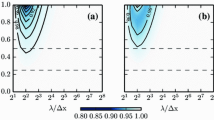Abstract
A 2006 article in Boundary-Layer Meteorology by G. Treviño and E.L Andreas presents a derivation that questions the use of time averaging for computing turbulence statistics. Their derivation shows that time averaging over a finite interval always leads to a zero integral time scale. As a result, Treviño and Andreas argue that any turbulence quantities derived from time averaging are tainted and incompatible with the Navier–Stokes equations. While Treviño and Andreas are correct that time averaging does produce integral scales that are quite different from what researchers commonly expect, this comment demonstrates that the theoretical implications are not as dire as they claim.
Similar content being viewed by others
References
Arya SP (1999). Air pollution meteorology and dispersion. Oxford University Press, New York, 310 pp
Batchelor GK (1949). Diffusion in a field of homogeneous turbulence I. Eulerian analysis. Aust J Sci Res 2: 437–450
Chatfield C (2003). The analysis of time series: an introduction, 6th edn. Chapman & Hall/CRC, Boca Raton, 352 pp
Comte-Bellot G and Corrsin S (1971). Simple Eulerian time correlation of full- and narrow-band velocity signals in grid-generated ‘isotropic’ turbulence. J Fluid Mech 48: 273–337
Lenschow DH, Mann J and Kristensen L (1994). How long is long enough when measuring fluxes and other turbulence statistics? J Atmos Ocean Technol 11: 661–673
Lumley JL and Panofsky HA (1964). The structure of atmospheric turbulence. Wiley-Interscience, New York, 239
Mahrt L (1998). Flux sampling errors for aircraft and towers. J Atmos Ocean Technol 15: 416–429
Monin AS and Yaglom AM (1971). Statistical fluid mechanics: mechanics of turbulence, vol 1. The MIT Press, Cambridge, 769 pp
Press WH, Teukolsky SA, Vetterling WT and Falnnery BP (1992). Numerical recipies in C, the art of scientific computing, 2nd edn. Cambridge University Press, New York, 994 pp
Tennekes H and Lumley JL (1972). A first course in turbulence. The MIT Press, Cambridge, 300 pp
Treviño G and Andreas EL (2006). Dynamical implications of block averaging. Boundary-Layer Meteorol 120: 497–508
Author information
Authors and Affiliations
Corresponding author
Rights and permissions
About this article
Cite this article
Eckman, R.M. Comment on “Dynamical Implications of Block Averaging” by G. Treviño and E.L Andreas. Boundary-Layer Meteorol 127, 345–351 (2008). https://doi.org/10.1007/s10546-008-9263-4
Received:
Accepted:
Published:
Issue Date:
DOI: https://doi.org/10.1007/s10546-008-9263-4




